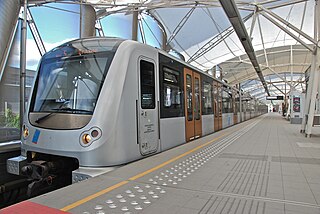
The Brussels Metro is a rapid transit system serving a large part of the Brussels-Capital Region of Belgium. It consists of four conventional metro lines and three premetro lines. The metro-grade lines are M1, M2, M5, and M6 with some shared sections, covering a total of 39.9 kilometres (24.8 mi), with 59 metro-only stations. The premetro network consists of three tram lines that partly travel over underground sections that were intended to be eventually converted into metro lines. Underground stations in the premetro network use the same design as metro stations. A few short underground tramway sections exist, so there is a total of 52.0 kilometres (32.3 mi) of underground metro and tram network. There are a total of 69 metro and premetro stations as of 2011.

Arts-Loi (French) or Kunst-Wet (Dutch) is a Brussels Metro station on lines 1, 2, 5 and 6. It is located in the City of Brussels, Belgium, under the intersection of the Rue de la Loi/Wetstraat and the Avenue des Arts/Kunstlaan, after which it is named, the latter street being part of the Small Ring.

Heysel or Heizel is a Brussels Metro station on the northern branch of line 6. It is located in Laeken, in the north-west of the City of Brussels, Belgium, and serves the Heysel/Heizel Plateau, famous for the World's Fairs of 1935 and 1958, the King Baudouin Stadium and the Atomium. The Bruparck entertainment park and the Centenary Palace, home to the Brussels Exhibition Centre, are also located nearby.

Houba-Brugmann is a Brussels Metro station on the northern branch of line 6. It is located under the Avenue Houba De Strooper/Houba De Strooperlaan, near Brugmann University Hospital, in Laeken, in the north-west of the City of Brussels, Belgium. The station is jointly named after the city official Louis Houba and the 19th-century philanthropist Georges Brugmann.

Stuyvenbergh is a Brussels Metro station on the northern branch of line 6. It is located under the intersection of the Avenue Houba De Strooper/Houba De Strooperlaan, the Avenue Émile Bockstael/Émile Bockstaellaan and the Avenue De Smet De Naeyer/De Smet De Naeyerlaan, in Laeken, in the north-west of the City of Brussels, Belgium. The station takes its name from the Château of Stuyvenberg, which is just to the east, in Laeken Park.

Bockstael is a Brussels Metro station on the northern branch of line 6. It is located in Laeken, in the north-west of the City of Brussels, Belgium. The station received its name from the aboveground square Place Émile Bockstael/Émile Bockstaelplein, itself named after the liberal politician and former mayor of Laeken, Émile Bockstael.

Pannenhuis is a Brussels Metro station on the northern branch of line 6. It is located in Laeken, in the north-west of the City of Brussels, Belgium. The station takes its name from the street Rue du Pannenhuys/Pannenhuisstraat, which is just to the west, in the municipality of Jette.
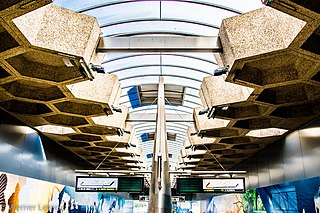
Belgica is a Brussels Metro station on the northern branch of line 6. It is located in the municipality of Jette, in the north-west of Brussels, Belgium. The station received its name from the aboveground Boulevard Belgica/Belgicalaan, itself named in honour of RV Belgica, the ship that carried the first Belgian polar expedition to the Antarctic in 1897.

Beekkant is a Brussels Metro station on lines 1, 2, 5 and 6. It is located under the Boulevard Edmond Machtens/Edmond Machtenslaan in the municipality of Molenbeek-Saint-Jean, in the western part of Brussels, Belgium. The station's name translates into English as "Brookside".

Porte de Hal or Hallepoort (Dutch) is a rapid transit station in Brussels, Belgium, consisting of both a metro station and a premetro station. The station is located in the municipality of Saint-Gilles, south of the City of Brussels, under the Small Ring and next to the 14th-century Halle Gate, after which it is named. It is one metro stop away or about ten minutes' walk from Brussels-South railway station.
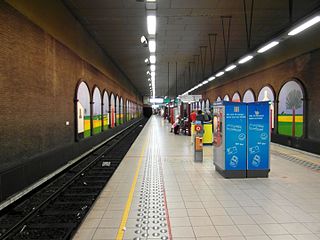
Clemenceau is a Brussels Metro station on the southern segment of lines 2 and 6. It is located under the Rue Jorez/Jorezstraat, close to the Avenue Clemenceau/Clemenceaulaan, in the municipality of Anderlecht, in the western part of Brussels, Belgium. The station takes its name from that nearby avenue, itself named after Georges Clemenceau, a former Prime Minister of France.

Delacroix is a Brussels Metro station on lines 2 and 6. It is located in the municipality of Anderlecht, in the western part of Brussels, Belgium. It is an elevated station, running parallel to the Rue Léon Delacroix/Léon Delacroixstraat, and forming a bridge-viaduct over the Brussels–Charleroi Canal, with entries and exits leading to and from both banks of the canal. The station takes its name from that nearby street, itself named after Léon Delacroix, Belgium's 22nd Prime Minister.
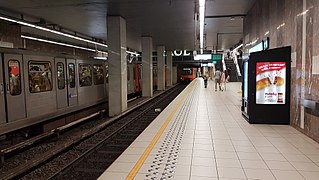
Louise (French) or Louiza (Dutch) is a Brussels Metro station on the southern segment of lines 2 and 6. It is located under the Small Ring at the Place Louise/Louizaplein, at the end of Avenue Louise/Louizalaan, in the City of Brussels, Belgium. The station takes its name from that nearby avenue, itself named after King Leopold II's eldest daughter, Princess Louise.
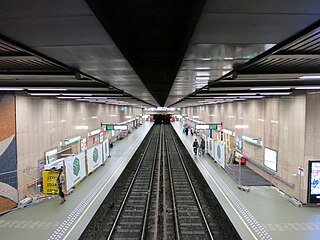
Trône (French) or Troon (Dutch) is a Brussels Metro station on the southern segment of lines 2 and 6. It is located under the Small Ring at the Place du Trône/Troonplein, near the Royal Palace, in the City of Brussels, Belgium.
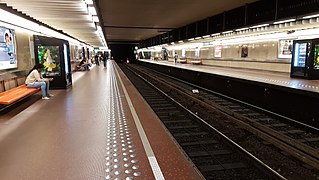
Madou is a Brussels Metro station on the northern segment of lines 2 and 6. It is located under the Small Ring at the Place Madou/Madouplein, next to Madou Plaza Tower, in the municipality of the Saint-Josse-ten-Noode, north of the City of Brussels, Belgium. The station takes its name from that aboveground square, itself named after the painter and lithographer Jean-Baptiste Madou.

Botanique (French) or Kruidtuin (Dutch) is a Brussels Metro station on the northern segment of lines 2 and 6. It is located under the Small Ring at the Rue Royale/Koningsstraat in the municipality of the Saint-Josse-ten-Noode, north of the City of Brussels, Belgium.
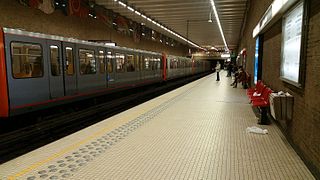
Ribaucourt is a Brussels Metro station on the northern segment of lines 2 and 6. It is located under the Boulevard Léopold II/Leopold II-laan in the municipality of Molenbeek-Saint-Jean, in the western part of Brussels, Belgium. The station takes its name from the Belgian noble family De Ribaucourt, as well as De Ribaucourt park and castle.

Line 2 is a rapid transit line on the Brussels Metro in Belgium operated by STIB/MIVB. It has existed in its current form since 4 April 2009, when the section between Delacroix and Gare de l'Ouest/Weststation was opened, which allowed to close the "loop" from and to Simonis/Elisabeth. The configuration of Simonis/Elisabeth though does not allow trains on line 2 to perform the loop several consecutive times in the same direction, i.e. a train running clockwise from Elisabeth will have to run counterclockwise from Simonis. The two termini of line 2 have thus received different names: originally Simonis (Elisabeth) and Simonis , changed in November 2013 to Elisabeth and Simonis. Between Yser/IJzer and the Porte de Hal/Hallepoort, the line runs under the Small Ring, which was itself built on the site of the former second walls of Brussels. The line crosses the municipalities of Koekelberg, Molenbeek-Saint-Jean, City of Brussels, Saint-Gilles and Anderlecht.

Line 5 is a rapid transit line on the Brussels Metro in Belgium operated by STIB/MIVB. It connects Herrmann-Debroux in the south-east of Brussels to Erasme/Erasmus in the south-west via the city centre. It has existed in its current form since 4 April 2009, when the section of former line 1A between Beekkant and Roi Baudouin/Koning Boudewijn was replaced by the section of former line 1B between Beekkant and Erasme. Starting from Herrmann-Debroux, the line crosses the municipalities of Auderghem, Etterbeek, City of Brussels, Molenbeek-Saint-Jean, Koekelberg and Anderlecht. It serves 28 metro stations and has a common section with line 1 between Gare de l'Ouest/Weststation and Merode, and with lines 2 and 6 between Gare de l'Ouest and Beekkant. At Arts-Loi/Kunst-Wet, the line also connects with lines 2 and 6. Railway connections are possible at Brussels-Central, Brussels-Schuman, Merode and Brussels-West.
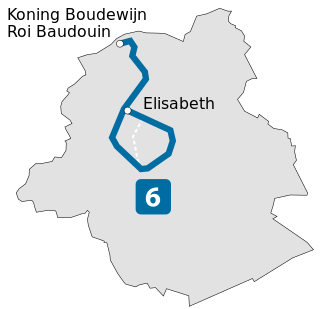
Line 6 is a rapid transit line on the Brussels Metro in Belgium operated by STIB/MIVB. It connects Roi Baudouin/Koning Boudewijn in the north-west of Brussels to Simonis/Elisabeth to the north-west of the city centre, then performing a counterclockwise "loop" around the centre up to Simonis again. During this loop, the line runs under the Small Ring, from Porte de Hal/Hallepoort to Yser/IJzer. It has existed in its current form since 4 April 2009, when it replaced former line 1A between Roi Baudouin and Beekkant. It serves 25 metro stations and has 26 stops, metros on that line stopping twice at Simonis. The Simonis-Elisabeth loop is also served by line 2. The line has also a common section with lines 1 and 5 between Gare de l'Ouest/Weststation and Beekkant. A connection with those lines is also possible at Arts-Loi/Kunst-Wet. Starting from Roi Baudouin, the line crosses the municipalities of the City of Brussels, Jette, Koekelberg, Molenbeek-Saint-Jean, Anderlecht and Saint-Gilles.




















